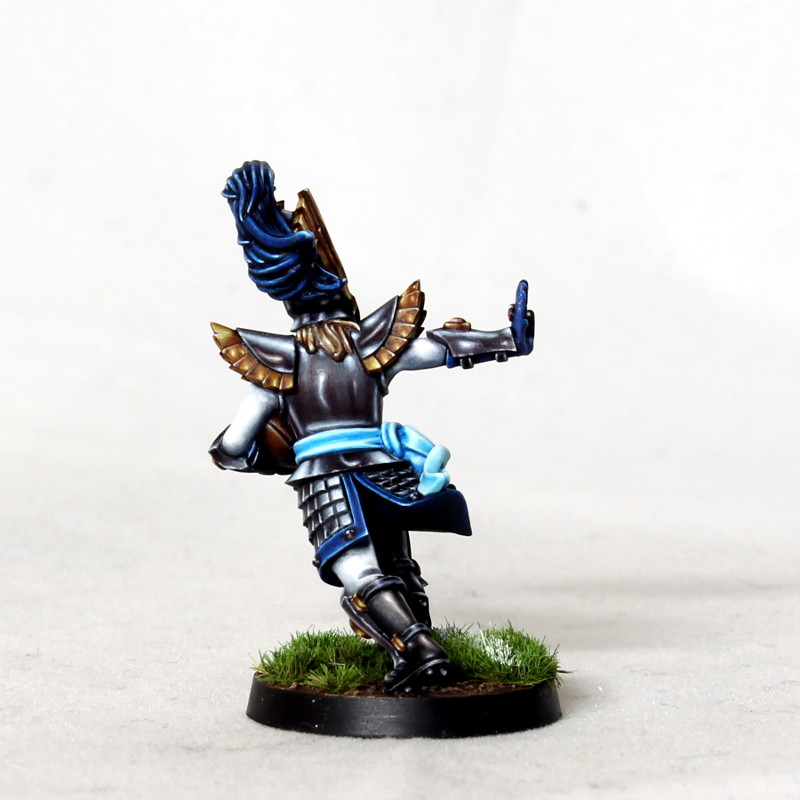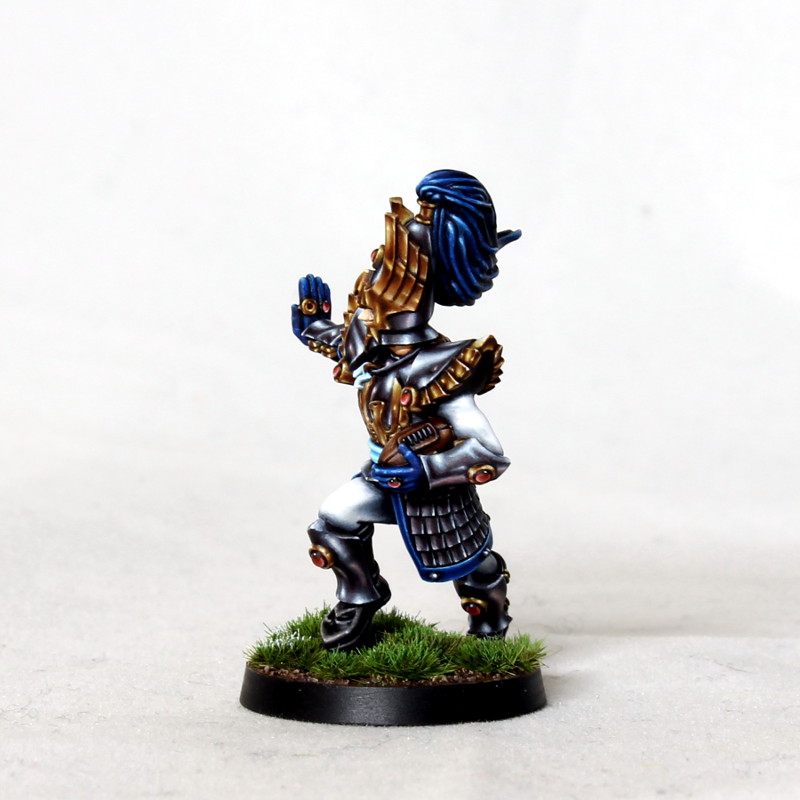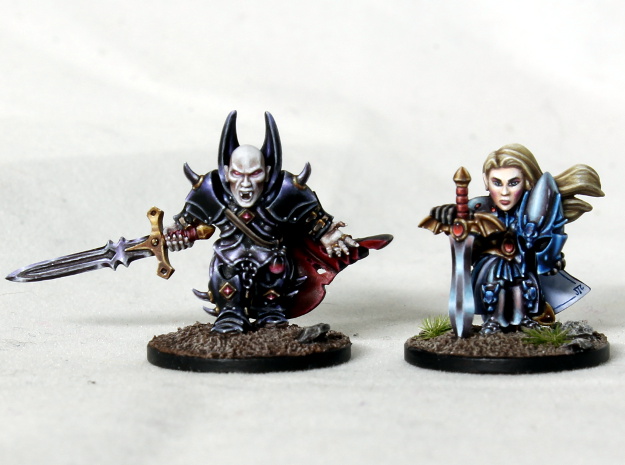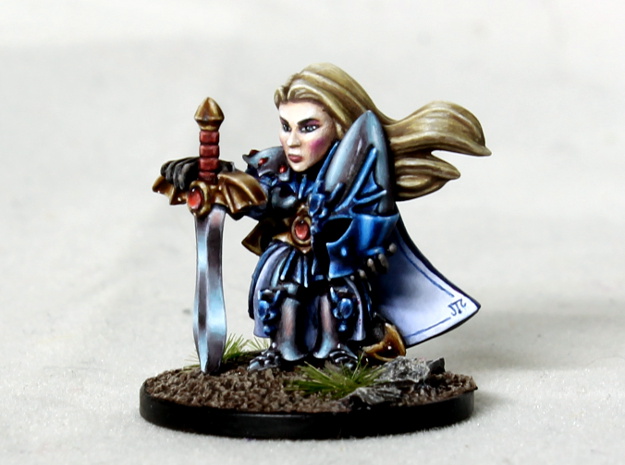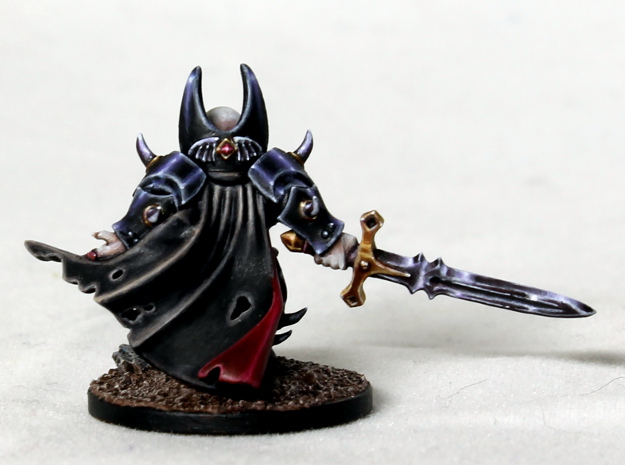Tapping into the strong vein of nostalgia that runs through many of us hobbyists of a certain age, Games Workshop have been revisiting many of their classic 90s miniatures in recent years. This year it was the turn of the venerable Commander Dante to cross the rubicon primaris and be re-imagined in glorious plastic.

On the left here we have classic 90s Dante, sculpted by the incomparable Jes Goodwin, and on the right we have the 2023 incarnation (not to scale), designer unknown. I spent many hours as a teenager staring at the 90s miniature and it’s one of my all time favourites. It superbly captures that essence of the gold clad angelic commander leading the Blood Angels chapter into battle, as seen in the legendary Dave Gallagher artwork. Clearly it suffers a bit from the limitations of the casting technology at the time – most notably around the head where the halo in particular is rather more solid than could be wished. And by modern standards it is rather small, although personally I don’t have a problem with that, and rather regret the relentless embiggening of everything.
When I saw the new version I have to say that unfortunately I was initially a little disappointed. There are certainly some good features – I like this solution for the halo, and the addition of a loincloth and the extra flaps on the jump pack are improvements to my eye. The paint job is of course superb; I don’t know which of the ‘Eavy Metal team painted it but they certainly earned their pay that week!
Before going on to mention some of the areas that I’m not so keen on, I do want to emphasize the reality that the designer was working to a deadline (you would be expected to complete a miniature like this in a maximum of 4 weeks when I was in the studio, and bear in mind that that includes the time needed for concepting, sculpting, and engineering, plus losing a fair bit of time in various meetings) and so we shouldn’t expect miracles. There’s absolutely nothing wrong with the miniature, and I’m sure plenty of people have bought it and are very happy with it. The lengthy wait I had for it to come back into stock certainly suggests that was the case! My criticisms are of course down to a matter of personal taste.
With that caveat out of the way, the main issue I have with the new miniature is the pose. It’s probably just me being a bit dim but I can’t figure out what Dante is supposed to be doing on that bit of ruined masonry. Is he taking off or landing? Unfortunately the flow of the loincloth and purity seals mean that it doesn’t read like either to me, which leaves me with the awkward feeling that he’s actually just balancing there on his toes. I understand that the designer wanted to elevate him to emphasize the fact that he can fly, I just feel it’s a bit clumsy.
The other element I don’t particularly care for is the head. Although the halo and laurels are an improvement, the way that the death mask of Sanguinius has been grafted onto a standard mk 10 helmet seems a bit awkward, and I feel that the face itself has lost the character of the original. And personally I would have liked to have seen Dante get wings, like the Sanguinary guard. The original sculpt predates this kit by many years, but now that winged golden Blood Angels exist, it seems weird that the commander doesn’t get this embellishment. I expect that if the designer considered this aspect, then they may well have been limited by the constraints of frame space, but looking at how much space on the sprue is consumed by the terrain feature and the many pieces of the jump pack, I wonder if something could have been done.

Of course, it’s all too easy for me to sit here away from all the pressures of the studio, indulging myself in a spot of armchair sculpting. Time to get out the trusty Wacom tablet and get to it! I did consider a conversion but when I tried that with the warlock I ended up with something that didn’t exactly match my vision for the piece and wished I’d just sculpted it from scratch in the first place. The first thing I did here was create a very rough Dante T-pose and use it to try out a few different poses and compositions. I looked at having him on foot, but it really felt like he needed to be airborne, so I looked at different ways of making it look like he’s in the air without the necessary attachment to something solid being too obvious. I printed out a few scaled down versions so I could see how they would work in reality and eventually settled on the composition that you can see here.

The concept is that Dante is descending into the war torn ruins of some kind of suitably gothic building, while firing his inferno pistol at an unseen villain. The pose actually ended up quite similar to the latest GW version, although I found that I preferred more of a bend in the right leg and with the axe mortalis raised up, more like the 90s original. I used the right wing as the attachment point to the ruins and I think this solution works reasonably well, although it limited how thin I could make the wings as I needed it to give a sufficiently large contact point, and be solid enough to support the weight of the whole model.

To help sell the idea that Dante is descending, I retained the loincloth but had it folded up underneath him, and made use of some unfeasibly long purity seals flapping in the breeze. Are they too long? Possibly, but when I tried making them closer to a more standard length I felt that the composition was weaker, and I comforted myself that the Sanguinor has incredibly long pieces of parchment keeping him in the air, so it’s not entirely without precedent. The shape of the wings does not follow the template set down by the Sanguinary guard. I tried it, but the shape I ended up with felt more dynamic in this case (it’s similar to the plastic Blood Angels chaplain with jump pack).

The weapons are pretty much exact matches to the GW versions, as I was able to take measurements from the plastic once I finally got it in my hands. I did make an adjustment to the design of the axe, just to put the original mini skull power node back in and go back to just one node, as I think it looks better. The halo is also a copy of the new version, but for rest of the head I have tried to go back towards Jes’ original. For the jump pack I’ve switched out Dante’s classic twin thruster version for the design that comes with the Sanguinary guard. I did try and integrate the wings with the other type, but it just doesn’t work well. I made a few adjustments to the armour, but nothing massively significant except for reintroducing poleyns (knee armour). Again, just personal taste here.

I’ve never been much of a fan of making bases, so it obviously made sense to give myself the task of making a particularly large one for this miniature. Unfortunately it’s necessary to give Dante sufficient height, so I just had to grit my teeth and get on with it. My intention is that more texture and debris would be added to the base prior to painting – what you’re seeing in these images is just the stuff that gets printed. The base is a 50 mm diameter, so exactly the same footprint as the GW version!

So there you have it – my own version of Dante, chapter master of the Blood Angels. After a bit of trial and error I worked out the best way of splitting him up to enable easy printing and painting. Unfortunately I did end up needing to print that huge scenery piece a few times, and with a 0.03 mm layer height those were some loooong prints!
The question now is, am I ever going to paint him? Looking at the files on my computer reveals that it has already been 5 months since I last worked on this project, and so far I just haven’t been able to find the motivation to do it. After the trauma of sculpting it, I think maybe it’s the thought of painting the base that is preventing me from picking up the brush, although all that gold armour doesn’t appeal very much either! I have to admit that it seems a shame not to have a completed physical representation of the work though, so perhaps the thing to do is to paint a copy to something less than my best standard, as I did with Alarielle last year.
Finally, I realise I’m probably wasting my time here, but please don’t bother contacting me requesting the STLs. It’s not going to happen, sorry.



































